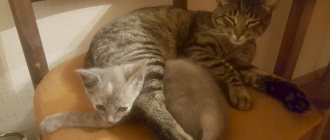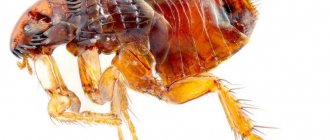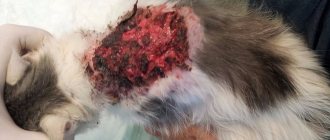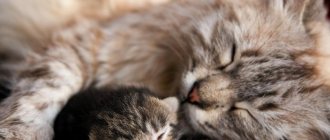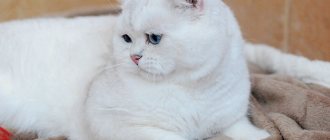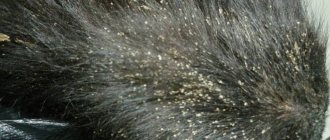The birth of offspring is a very pleasant and memorable moment, both for the cat itself and for its owners. It would seem that all the worst is over, the cat has successfully given birth to healthy offspring, and now all attention needs to be switched to newborn kittens. But not everything is so simple, in cats, against the background of the characteristics of the body, a disorder of the nervous system is possible , which is expressed in the appearance of a disease called postpartum eclampsia in cats. In this article we will look at the causes of this disease, symptoms, as well as treatment methods.
Causes
Knowing the causes of postpartum eclampsia in cats is very important. If we talk about eclampsia in cats, it is worth mentioning that the disease occurs in pets only during the postpartum period. The push effect itself is considered a very powerful nervous disorder, which can be caused by three reasons:
- genetic predisposition - some animals are more prone to eclampsia at the genetic level. They may have a weak nervous system, or the code is inherent in natural features;
- metabolism - this factor can depend both on diet and on nervous disorders that can be caused by severe stress;
- factors whose influence comes from the outside - these reasons include difficult or too frequent childbirth. Lack of nutrients, in our case calcium.
Risk group
Cats of different ages and genders can be susceptible to the disease.
Animals at risk include:
- primiparous;
- with multiple pregnancy;
- having calcium deficiency during previous births;
- those receiving an unbalanced diet or medications that reduce calcium levels in the blood;
- aged.
Symptoms
Like many other diseases, eclampsia is accompanied by a number of symptoms, knowledge of which can greatly make life easier for both the pet and the owner. Understanding the symptoms of a particular disease, the owner has the opportunity to quickly respond and seek help from a veterinarian. It is important to understand that the owner’s task is not to identify the disease, but to quickly react to its manifestation.
- inappropriate behavior of the animal - the cat may seem confused, as if it does not understand what is happening around;
- mood swings - if a moment ago the cat was the sweetest and benevolent creature, then after a couple of minutes this can be replaced by sudden aggression and a fit of rage;
- mastitis - may appear during eclampsia;
- temperature change - the thermometer readings do not increase, but rather become lower. This is one of the signs of the disease;
- coordination - the animal may walk staggering. There is no need to confuse weakness in the limbs and lack of coordination, these are different symptoms;
- pupils - as a rule, they are slightly dilated;
- convulsions - can be observed in different limbs.
Diagnostics
Before prescribing proper treatment, it is necessary to diagnose the body. The fact is that the symptoms that a cat exhibits with eclampsia are very similar to ordinary nervous disorders. And if sometimes an inexperienced specialist can make a mistake in making a diagnosis, there can be no talk of any self-diagnosis methods by untrained people. Our veterinary center offers the services of only highly qualified specialists who know a lot about their business and bear full responsibility for their actions.
It is impossible to say exactly what examinations a doctor may prescribe when detecting eclampsia in cats. But we can say for sure that taking blood tests will be almost necessary . Since this is a basic set of tests that allows you to see the general condition of the body and individual organs.
Basic information about the disease
Diagnostic methods include a general examination of animals, taking medical history data, conducting serological and laboratory tests. With eclampsia in cats, changes in pH levels and a decrease in the concentration of calcium in the bloodstream (hypoglycemia) are noted. After diagnosis, cats with eclampsia are prescribed complex therapeutic, etiotropic therapy, which involves intramuscular, intravenous administration of calcium gluconate. In the acute stage - magnesium sulfate. As maintenance therapy, veterinary specialists administer nutritional drips, administration of glucose solution, prednisone, cardiac glycosides, and sedatives (Diazepam). Treatment of eclampsia with corticosteroids requires caution and strict dosage, as they reduce the absorption of calcium in the body.
Animals are prescribed a therapeutic diet rich in calcium, phosphorus, magnesium, a diet, and mineral and vitamin complexes are prescribed. The dosage of calcium, minerals and vitamins is prescribed on an individual basis. Cat owners must provide their animals with complete rest and proper care. Your pet should be protected from stress and any irritating factors.
Kittens are transferred to artificial feeding until the symptoms of the disease in the mother cat completely disappear and her physical condition normalizes. In especially severe cases, animals are transferred to inpatient treatment (hospitalization) in a veterinary hospital.
During acute attacks, you should not treat your cat yourself. You urgently need to call a veterinarian!
With timely diagnosis and timely, effective, correct treatment, the prognosis is favorable. Symptoms of eclampsia in cats go away within 5-8 days.
During pregnancy, natural changes occur in which calcium from the mother’s body is spent on the formation of the kittens’ skeleton in the womb. Parathyroid hormone is responsible for the absorption and entry of this element into the bones and muscles (it is produced by the parathyroid gland).
Sometimes at the end of pregnancy or after childbirth, the mentioned gland cannot be rebuilt and provide the cat’s increased needs for calcium. As a result, only milk is saturated with it, but not the animal’s body. These processes explain the mechanism of the pathology, and their study allows us to understand how eclampsia develops in cats after birth. Treatment of the disease involves rest and saturation of the body with calcium.
The development of eclampsia is facilitated by poor nutrition and diseases of the digestive system, which impair calcium absorption. Most often, this pathology is diagnosed in primiparous animals. Cats who have given birth to many kittens are prone to it, as their calcium needs are even higher.
This condition is observed in cats that are pregnant or have recently given birth. The main reason for the development is an acute lack of calcium in the body.
This mineral is responsible for the formation of bone tissue and joints, and is involved in the regulation of the cardiovascular system. Calcium is responsible for transmitting impulses to nerve endings.
If the body of a pregnant cat does not have enough of this substance for the normal formation of fetuses, calcium begins to be washed out of the bones. As a result, eclampsia develops after childbirth.
The following animals are primarily at risk:
- Cats that have previously suffered from eclampsia, or have relatives with such a disease in their pedigree.
- Animals bearing a large number of kittens (at least 6).
- Pets suffering from chronic or acute diseases of the digestive system.
- Elderly pets (aged 7-8 years and older).
Eclampsia usually develops in the first 30 days after birth. Veterinarians note that any cat can suffer from this disease, regardless of breed.
Cats carrying more than 6 kittens are at risk. It is very important to take action after the first signs of the disease appear.
READ Gray cat character and habits
If the cat begins to rush around, behaves restlessly, and bites kittens, give her 2.5 ml of Calcium gluconate intramuscularly (it is better to inject 1.25 ml into each hind paw). This drug can be replaced with Borgluconate (it is administered subcutaneously).
If relief does not occur, repeat the procedure after half an hour, but keep in mind that no more than 10 ml of the drug can be administered to the animal per day.
After the acute condition is relieved, Calcium gluconate is given once a day, 2.5 ml for a week. Then the dosage is reduced to 1.5 ml, treatment is continued for another 8-10 days. If there are no obvious signs of eclampsia, Calcium gluconate can be taken orally in the same dosage.
During an exacerbation, you can make a cocktail of drugs and administer it subcutaneously (take the drugs in the given order):
- Borgluconate – 1 ml;
- Glucose 5% (can be replaced with NaCl) – 2 ml;
- Travmatin – 1 ml;
- Gamavit – 1 ml.
If a cat has eclampsia, it is necessary to administer Calcium gluconate or Borgluconate.
The doctor will do tests and prescribe supportive treatment. In case of severe exacerbation, kittens are taken away from the cat for a day or until the animal’s condition returns to normal.
Postpartum tetany or milk fever (synonyms for eclampsia) occurs due to the fact that the animal’s body does not receive the required amount of calcium. This element is especially necessary for the body at the end of pregnancy and in the first months of breastfeeding. This explains the fact that the disease most often occurs in cats at 6-7 weeks of pregnancy and in the first few days after birth.
Eclampsia develops in pregnant and lactating cats.
There is only enough calcium in the animal’s blood to saturate the milk with it. And his mother herself misses him. This leads to sharp contractions of the skeletal striated muscles. Outwardly, these convulsions resemble the clinical picture of strychnine poisoning or the development of tetanus.
Since the symptoms of eclampsia after childbirth are quite similar to the signs of other diseases, only a veterinarian can make an accurate diagnosis.
To do this, you will need to carry out a number of activities:
- Get information about the animal's life, previous pregnancy, childbirth and the postpartum period.
- Conduct an examination of the animal to exclude neurological diseases, spinal cord and brain injuries.
- Determine calcium concentration using a biochemical blood test.
If there are signs of eclampsia, the veterinarian will draw blood from the cat to determine calcium levels.
In addition to calcium levels, the doctor will also prescribe a blood test for sugar, a decrease in which can also accompany eclampsia.
Treatment
If the diagnosis is confirmed by a doctor, treatment should begin. Therapeutic measures should begin immediately. Because the slightest delay in providing veterinary care can result in death for your pet.
Treatment methods do not have a wide range and are limited to saturating the animal’s body with calcium. But not everything is as simple as it might seem at first glance . The dosage of the drugs used, no matter what form they are in, tablets or injections, should be determined only by a veterinarian. A lack of calcium can result in an excess, which is not good for your pet. There is no need to look for extremes, you need normal levels of the substance in the body.
The treatment itself most often takes the form of injections to the cat. A solution containing calcium is administered intravenously to a sick cat. Some veterinarians advise using calcium intended for human consumption, this is due to the insufficient absorption of the veterinary product. In order for the solution to be better accepted by the body, it should be heated to the desired temperature - this is slightly above room temperature.
Recommendations and advice if your cat is receiving anticonvulsants
In general, if a cat receives such drugs, it is necessary to preserve its life.
There are several “golden rules for treating seizures”:
- Always follow the instructions. The dosage and schedule of taking the drug are important to maintain sufficient levels of the drug in the blood.
- Never stop treatment suddenly, as this may lead to uncontrolled convulsions and seizures.
- Always inform your veterinarian in advance when a drug or supplement is running low. This is especially important if the drug needs to be ordered specifically for your cat.
- Store medications in a safe place, out of the reach of children.
- Be careful with other drugs and supplements you give your cat. If in doubt, consult your veterinarian.
Eclampsia in cats after birth: first aid at home
Before the veterinarian arrives, you can provide your cat with assistance that will alleviate its condition or prevent complications of eclampsia in cats after birth. But first aid should not be confused with self-medication . Only a doctor should treat an animal. Otherwise, you will only cause him harm, which can lead to death. Below are basic guidelines for providing first aid to a cat :
- isolation of the animal from its offspring - to avoid harm;
- rest - the animal should be at rest and avoid stressful situations;
- atmosphere - in the room where the isolated pet is located there should be dim light and clean air.
- to avoid the consequences of seizures - to do this, you need to cover the animal on all sides with soft blankets or pillows.
In what situations can a disease not be treated at home?
Eclampsia is a disease that, if not properly treated, can lead to the death of an animal. A cat can die due to high body temperature (above 41 °C) or due to brain damage and depression of the respiratory center.
There are signs of eclampsia in cats, which indicate a severe course of the disease and the need for hospital treatment. If after the start of therapy there is no improvement in the animal’s condition for a couple of hours, this may indicate the need for intravenous infusion of the drug.
In cases of prolonged increase in body temperature, which is not brought down by medication and home methods, it is also recommended to hospitalize the cat. This must be done to avoid destruction of protein structures and the development of severe seizures. In the hospital, it is possible to administer medications under ECG monitoring, which makes it possible to recognize cardiac disorders in time and begin to fight them.
Prevention of eclampsia in cats
Better than any treatment is the absence of disease. Preventive measures will help prevent the onset of illness in your pet. They consist of certain actions aimed at improving the health of the animal and its conditions of detention. All recommendations are created by leading veterinarians. In the case of eclampsia, strong attention needs to be paid to the cat during pregnancy. Below are some of them:
- nutrition - when an animal carries offspring in its tummy, it should be remembered that it shares all the nutrients it receives with the future kittens. That is why it is necessary to fully saturate the body with all the necessary microelements;
- emotional state - during pregnancy you should avoid various stresses that can have a detrimental effect on both the health of the fetus and the health of the cat itself;
- Other diseases - diseases suffered by animals during pregnancy will in any case leave a mark on the general condition.
Characteristic clinical signs
The symptoms of the disease are pronounced, so it is almost impossible to miss the signs of eclampsia.
These include:
- Refusal to feed and increased salivation.
- Increased temperature and irregular heart rhythm.
- Frequent breathing and depression.
- Paleness of the conjunctiva and mucous membranes.
- Behavioral disturbance - the animal begins to worry or, on the contrary, behaves inhibited. Concern for the kittens increases, the cat hides them or moves them from one place to another. The mother can also abandon her offspring.
Severe symptoms include:
- loss of consciousness;
- presence of seizures;
- numbness of some parts of the body;
- loss of coordination.
All these signs of milk fever are increasing. And you need to be able to notice them in time and take the necessary measures.
